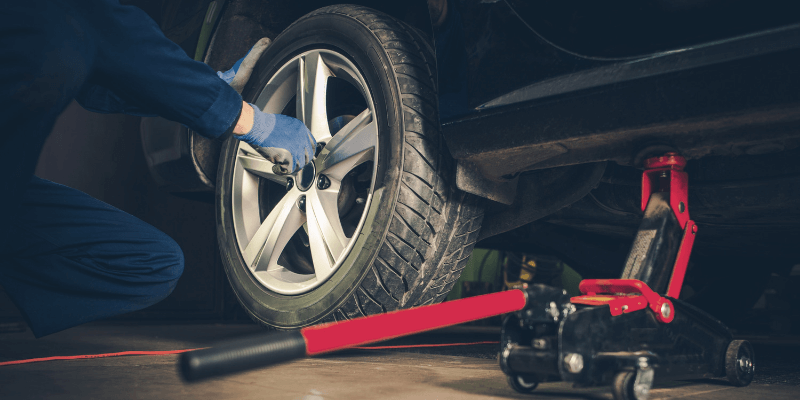 Swipe for more categories
Swipe for more categories 
Tire Rotation: When and How to Get it Done
Warning: Undefined variable $post_id in /var/www/dsw/wp-content/themes/DriveSmart_2024_v1.1/single.php on line 27
May 13, 2019
Warning: Undefined variable $post_id in /var/www/dsw/wp-content/themes/DriveSmart_2024_v1.1/single.php on line 75
Tire Rotation: When and How to Get it Done
Warning: Undefined variable $post_id in /var/www/dsw/wp-content/themes/DriveSmart_2024_v1.1/single.php on line 76
May 13, 2019
When you’re driving your car, safety is always the most important thing. That’s why vehicles have seat belts and airbags. However, another important factor to consider is the integrity of your tires. Without proper care, such as routine tire rotation, tires wear out quickly. Having a tire blowout while you’re driving is extremely dangerous as it may cause you to lose control of your vehicle. Learn when, where, and how to get a rotation done right here.
What is a Tire Rotation?
Tire rotation is simply the process of alternating the position of the wheels and tires on your vehicle in order to ensure that the tires wear evenly. Generally, the tires will be repositioned from front to back or side to side.The tires in the front or back will sometimes also switch sides when this is done. Need for rotation is based on a time frame or a prescribed length of mileage. This is done for safety purposes and to guarantee that you get the most use out of the tires before they need to be replaced.

How Often to Rotate Tires
Of course, people will wonder, “How often should I rotate my tires?”. The vehicle owner’s manual usually provides a specific guideline to that question. Most professionals say that the procedure should be done every 6,000 to 8,000 miles or every six months, depending on the amount of driving that is done in a particular car. In many cases, the job can be done whenever it’s time for an oil change.
It’s important to know when to rotate tires because, if the treads wear out on the front tires more quickly than those in the rear, this makes the vehicle harder to control. This is especially true when driving in the rain and the road is wet. If you are unsure about your vehicle’s tires based on their age, or if you bought them used, ask a professional how often should tires be rotated.
How to Rotate Tires: Getting Started
If your looking to save some money (as we all are), it’s a good idea to learn how to rotate tires at home. It’s not a very difficult procedure, but before you begin, learning the correct way to rotate tires is a necessity. This section is designed to teach you how to do a tire rotation safely and quickly.
A proper tire rotation will require the following tools:
- Lug Wrench: A lug wrench (or torque wrench) is a simple instrument that can be purchased anywhere tools are sold. Lug wrenches cost between $8 and $30.
- Car Jack: For this particular job, the jack that came with your car is not recommended. It’s best to use a hydraulic floor jack for safety purposes. A hydraulic floor jack costs roughly $100.
- Jack Stands: These are going to hold the vehicle up while you take off and switch the tires. A set of jack stands will cost about $30.
Directional and Non-Directional Tires
Before you can begin removing and switching your tires around, you must determine whether your car has directional tires or non-directional tires.

- Directional tires are designed only to turn one way. The tread patterns and grooves are arranged for optimal handling when spun in a particular direction. So they are made to be used specifically on the left or right side of the car. The arrows on the sidewall of the tire will indicate which way the tire is meant to turn. Directional tires can be rotated back-to-front or front-to-back only.
- Non-directional tires have tread patterns that allow the wheel to turn in any direction. This means that the tires can be switched from left to right, or vice versa. The best way to rotate non-directional tires is in an “X” motion. This means that the rear-left wheel becomes the front-right, and the rear-right becomes the front-left. However, if the vehicle has front-wheel drive, the front tires should be moved straight back while the rear tires are put on opposite sides in the front of the car.
Spare Tire
If your vehicle came equipped with a full-size spare tire, it’s suggested that you incorporate the spare into the rotation. This allows each tire on the vehicle to “take a break”. Larger vehicles and SUVs usually come with a full-size spare. This is not common with smaller vehicles. Ordinary sedans do not have full-size spares. They usually come with a smaller/lighter spare that is not made for long distance driving. Such a tire should not be regularly added to the rotation.
How to Rotate Tires: The Procedure
Activate the parking brake on the vehicle before you begin. This is for safety purposes. You may then use your lug wrench to loosen the lug nuts on each of the wheels. It’s best to loosen the lug nuts before lifting the car. If the vehicle is up on the jack stands and you find a stubborn lug nut, pushing and pulling on the lug wrench is going to jostle the vehicle, potentially moving it off of the jack stands. Loosening the lug nuts before the vehicle is lifted will make unscrewing them a lot easier.
Next you’re going to want to find your jacking point. It’s typically right behind the wheel well of the front tire, and just in front of the well for the rear wheel. Put your jack into position and jack the car up.
Now you can slide the jack stand under the car right next to the jack. They should both fit next to each other. Lower the car onto the jack stand. For safety reasons, it’s not recommended to have the car suspended by more than two jack stands at one time. You might also want to consider placing a tire under the car. In the event that the car drops off the jack stands, this will prevent damage to the vehicle. You can now unscrew the lugnuts and remove the tire.
Repeat these steps with each tire. Remember to set the wheels in a tire rotation pattern that is best suited for your vehicle and the type of tires you are using. Before lowering your vehicle. Screw all the lug nuts on by hand as tightly as you can.
Using the car jack, lower the vehicle back onto the ground. With your lug wrench, tighten the lug nuts until you’re satisfied that the wheel is adequately re-affixed to the vehicle. Always tighten the lug nuts diagonally from one another, rather than sequentially. By doing this, you’ll be able to confirm that the lug nuts are tightened evenly. Uneven tightening may end up warping the brake rotor.

Once you’ve switched places of all the tires, lowered the vehicle, and tightened all the lug nuts, your job is done! Record the mileage on the vehicle when your finished. Once you’ve put another five to six thousand miles on the car, it will be time to rotate the tires again.
How Long Does Tire Rotation Take?
It shouldn’t take much more than 20 minutes to rotate the tires on a vehicle. If you have only one jack stand, the activity will take a bit longer as you will have to keep lifting and lowering your vehicle for each tire.
Where to Get a Tire Rotation Done
If you aren’t particularly mechanically inclined, it may be best to take your car to a facility that can perform a tire rotation for you. Any repair shop or car dealership will be able to rotate the tires on your car. They will usually offer this when you bring the vehicle in for an oil change, but you can get it done whenever you feel it necessary.
Tire Rotation Cost
Getting a rotation done by a professional is relatively cheap. Depending on where you choose to go to have the job done, it will cost somewhere between $20 and $120. These days, a lot of dealerships offer packages where, for a nominal fee, you’ll get free oil change and tire rotation service for a predetermined time period. You can also save money by having your tires rotated when you buy a new tire. A tire shop will usually throw the rotation into the transaction free of charge.
Benefits of Tire Rotation
Safety is the main concern when considering tire rotation, by preventing uneven tire wear. Uneven wear will deplete the lifespan of your tires. Tire repair and replacement can get very expensive. A single tire will cost you at least $80, whereas a set of tires can run to upwards of $400. Tire rotation also helps improve gas mileage and it’s also a good way to keep your suspension healthy.
Check your mileage, find out if it’s time for a rotation to be done, and make sure your tires are healthy. When your tires are off the vehicle, inspect them for sidewall damage and tread damage. Check the tire pressure as well. Be sure to keep your tires in mind when you put mileage on your car in order to have them serviced as needed.
"> /var/www/dsw/wp-content/themes/DriveSmart_2024_v1.1/single.php on line 177
">
"> /var/www/dsw/wp-content/themes/DriveSmart_2024_v1.1/includes/quote-modal.php on line 8
">


